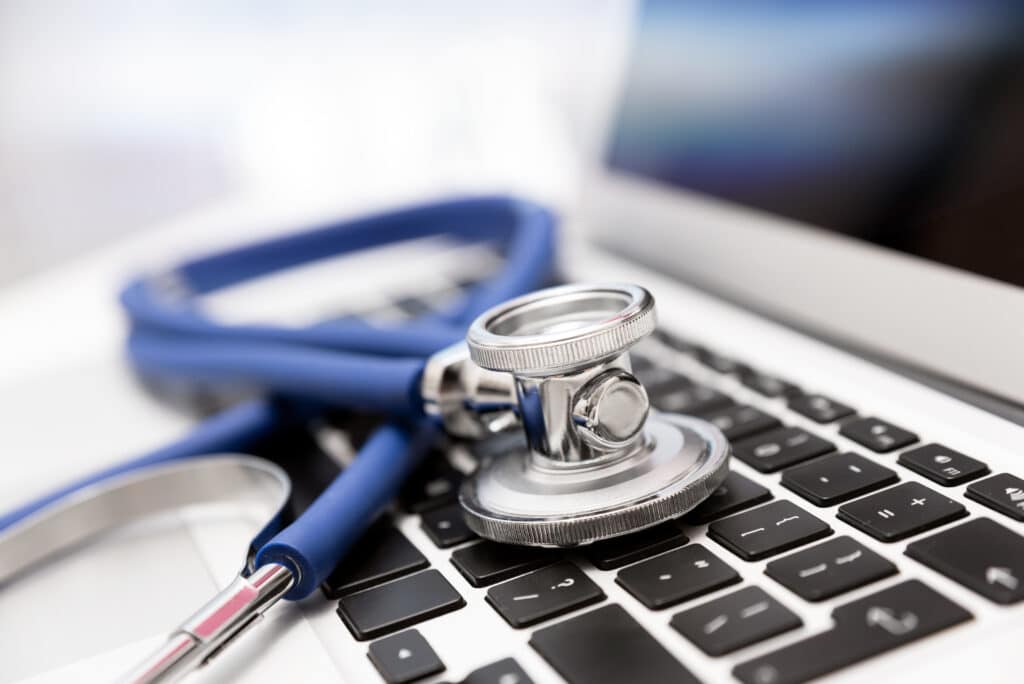
From technological breakthroughs to shifts in patient care models, the healthcare industry is marked by constant change and exciting innovation.
Understanding how healthcare trends shape and help the industry evolve is essential for healthcare providers, especially those operating small-to-medium-sized practices. Staying ahead of these developments is essential to keeping your practice competitive while also enabling you to deliver better outcomes for your patients.
Quick Article Recap:
- Why staying current with healthcare trends matters.
- Top healthcare trends and predictions and how your practice can benefit.
- Valuable tips for staying updated on industry trends.
The Importance of Staying Up to Date on Healthcare Trends
Consider this: the healthcare industry trends of today are shaping the patient expectations and operational realities of tomorrow. If you are not clued in, you risk falling behind.
Patients are savvy consumers. They want flexible, modern, and transparent healthcare services that feel personal. If your practice isn’t adapting to new technologies, evolving payment models, or the changing needs of the healthcare workforce, you could find yourself struggling to attract and retain patients—and staff.
Understanding how technology can alleviate administrative burdens and how new care models can optimize staffing also enables providers to be better equipped to support their teams, ensuring they can focus on what they do best: caring for patients.
Staying informed on industry trends offers several benefits, including:
- Improving patient care: New advancements in technology, such as genomics and AI, enable tailoring of interventions to patients, allowing providers to meet their needs better.
- Boosting efficiency and saving money: Staying current on tools like cloud computing and automation in healthcare can streamline your practice, reduce errors, and lighten your workload. This could save your practice both time and money (more on this later).
- Remaining competitive: Knowledge of trends such as advancements in telemedicine can help attract patients who value modern, convenient care.
- Ensuring compliance: Changes in regulations, billing, and coding require vigilance to avoid costly errors or penalties.
The constantly changing information can feel overwhelming, but arming yourself with the right insights gives you an edge to grow your practice and achieve long-term success.
So, what does the future of digital health look like? What trends are driving the biggest changes, and how does this affect your practice ecosystem? Read on to find out.
Key Healthcare Trends to Keep Your Eye On
Here are major trends poised to impact healthcare providers and how you can benefit from these advancements right now:
AI in Healthcare Innovation
Sessions such as “AI in Healthcare Forum: Practical Strategies for Empowering People, Processes, and Technology” dominated HIMSS (Healthcare Information and Management Systems Society) 2025, and with good reason.
From clinical decision support tools and ambient documentation to virtual triage bots and radiology imaging, AI solutions promise significant advancements in patient care.
For example, AI can help simplify complex diagnostics. Researchers at the National Cancer Institute and the Department of Energy are using AI to simulate the atomic behavior of the RAS protein, one of the most commonly mutated proteins in cancer. A better understanding of how RAS interacts with other proteins could help scientists find new avenues to target cancer-causing mutations in the RAS gene.
For small- to medium-sized independent practices, AI can be a game-changer for administrative tasks, helping streamline patient intake, automate documentation, and even assist with medical coding. By leveraging AI, providers can save time, collaborate more efficiently with care teams, and make better informed decisions.
What does the future hold?
- The AI in healthcare market size is expected to see significant growth and is forecasted to reach around USD 613.81 billion by 2034.
- A McKinsey survey found that 85% of respondents—healthcare leaders from payers, health systems, and healthcare services and technology groups—were researching or had already embraced gen AI capabilities.
Continued Rise of Value-based Care
The shift from “fee-for-service” to “value-based care” continues to gain ground. Payment models are increasingly focused on patient outcomes and the quality of care rather than just the number of services provided.
For practices, understanding these value-based care trends is vital. Value-based care promotes a proactive approach, emphasizing preventive care and effective management of chronic conditions.
This means embracing advanced tools for population health management and focusing on comprehensive care coordination to ensure your patients stay healthy and avoid unnecessary hospital visits.
The American Journal of Managed Care (AJMC) offers some key value-based care trends to follow:
- Ambulatory care, home health, and telehealth are being used more frequently. Telemedicine breaks geographical barriers, ensuring traditionally underrepresented communities receive care.
- Alternative approaches to patient engagement, such as telehealth, mobile apps, and remote patient monitoring tools are expected to become more widely adopted throughout healthcare systems.
- Preventative care is paramount as physicians are incentivized to address health conditions early rather than administering reactive treatment.
FROM ONE OF OUR PARTNRS: Preparing for Value-Based Reimbursement – Adapting Revenue Cycle Strategies for the Future

Changes in Telemedicine
The future of telemedicine is not just about video calls anymore. It’s evolving into sophisticated “hybrid care” models where virtual visits are seamlessly integrated with in-person care. Benefits of this model include:
- Streamlined workflows: For example, advanced telehealth platforms, equipped with HIPAA-compliant video and audio capabilities, mimic in-person visits, elevating the patient experience.
- Accessibility: Patients appreciate the convenience of telemedicine.
- Expanding your reach: You can manage certain conditions without requiring patients to visit the office and offer follow-up care.
- Eliminating geographical barriers: Whether it’s virtual consultations or remote monitoring of chronic conditions, providers can deliver real-time care to patients in remote areas or for those who struggle to attend in-person visits.
Expect continued growth in specialized telemedicine services and a focus on making these virtual platforms more interoperable with existing electronic health record (EHR) systems. The global telemedicine market is expected to reach $334.8 billion by 2032.
RELATED CONTENT: 10 Telehealth Best Practices You Need to Know
Emerging Remote Patient Monitoring Market
Remote patient monitoring (RPM) adoption is soaring. Experts valued the RPM market at $39.54 billion in 2023, and it is expected to reach $77.9 billion by 2029.
Devices such as smartwatches, blood pressure cuffs, and continuous glucose monitors are now common, enabling providers to track patient’s vital signs and other health data remotely. Combining AI with IoT (AIoT) continues to enhance healthcare outcomes by allowing the early detection of conditions, such as asymptomatic infections, through advanced data analysis.
As wireless data networks continue to advance (think 5G), the development of telehealth and remote monitoring platforms is expected to grow. For chronic disease management or post-op recovery, RPM offers invaluable insights, enabling you to intervene proactively if something changes.
This helps keep patients out of the emergency room and empowers them to take a more active role in their own health.
FROM ONE OF OUR PARTNERS: What Is Remote Patient Monitoring & Why Does It Matter?
Personalized Medicine Advancements
Imagine tailoring treatments to a patient’s unique genetic makeup. That’s the promise of personalized medicine.
For example, according to Intelligent Pharmacy, by leveraging AI and machine learning, healthcare professionals can analyze large and complex datasets generated by pharmacogenomics (a branch of genetics concerned with how an individual’s genetic makeup is likely to respond to therapeutic drugs).
AI enables providers to predict drug responses and tailor treatment plans to each patient’s specific genetic makeup. This personalized approach has the potential to:
- Improve drug selection, effectiveness, dosage, and safety
- Reduce adverse drug reactions
- Optimize treatment outcomes
While specialized labs might handle large-scale genomic sequencing, the insights derived from this field are becoming more accessible.
This means that even in a smaller practice, you might be using genetic information to guide medication choices or understand a patient’s predisposition to certain conditions, leading to more targeted care.
Push for EHR Interoperability and Data Sharing
Frustrated by siloed patient data? You’re not alone. The push for healthcare EHR interoperability solutions is stronger than ever. This means your system must be able to communicate with other systems, including hospitals, laboratories, pharmacies, and other healthcare specialists.
Improved interoperability reduces redundant tests, improves care coordination, and provides a more complete picture of your patient’s health history, saving you time and headaches. Interoperability also reduces the risk of adverse drug interactions, allergic reactions, and other medical errors.
According to a JMIR Medical Informatics paper, interoperability is likely to play a crucial role in personalized medicine, patent-centered services, public health monitoring, and telehealth advancements.
When it comes to integrated EHR and data-sharing solutions, keeping things simple in your practice is key. For example, EverHealth offers an integrated ecosystem of EHR, communication tools, practice management, and charge capture solutions. The product ecosystem offers user-centric software solutions that streamline daily operations, improve coordinated care, and connect you with patients—bringing you into the future.
FROM ONE OF OUR PARTNERS: Expert Insights – How Interoperability Strategies Offer a Holistic Approach to Healthcare Integration
Evolution of Wearable Health Technology
For your practice, more patients using wearable technology, such as smartwatches and fitness trackers, means more real-time information to inform your clinical decisions and engage patients in their well-being.
Think about how a patient’s continuous glucose monitor data can help you fine-tune their diabetes management in a way that periodical visits simply can’t. But what about the future?
Wearables are moving beyond the “hype” and focusing more on how they can help. Meaning, healthcare experts are exploring how these advancements can be further integrated into patient care plans.
The evolution of wearable health tech is bringing us devices that provide continuous, robust data on patient vitals and even early signs of illness. News Medical offers a few trends to watch for:
- Advances in microfabrication and flexible electronics enable continuous monitoring of metrics, including glucose and vital signs, through non-invasive methods such as sweat analysis and minimally invasive microneedles.
- Predictive analytics through AI-enabled biosensors empowers users and providers to proactively manage health, anticipate risks, and intervene before the onset of illness. Emerging technologies are enhancing their accuracy, comfort, and versatility.
- Future developments anticipate hybrid wearable-implantable systems that combine external monitoring with internal precision to achieve comprehensive health surveillance. These integrated systems could revolutionize telemedicine and remote patient care, providing highly personalized, real-time health management.
Benefits of Cloud Computing in Healthcare
If you’re not already leveraging the cloud, it may be time to consider it seriously. Cloud-based EHR solutions enhance collaboration, improve cybersecurity, and facilitate data accessibility across teams, even in remote settings.
Cloud computing in healthcare also offers incredible benefits for small to medium-sized practices. Here’s how:
- Cloud computing often comes with built-in security features, crucial for protecting sensitive patient data (think HIPAA compliance). Cloud-based EHRs also store patient data on remote servers, leading to better safety and security compared to on-premise systems.
- It enables flexible access to your systems from anywhere, which is beneficial for telehealth and remote work.
- Cloud-based systems are cost-efficient. For example, one market report reveals cloud solutions reduce the need for complex on-premise infrastructure and simplify data backup, security, and software updates.
The future will see AI-powered cloud services becoming increasingly integrated into cloud architectures. According to a cloud computing market growth report, major trends include the use of blockchain for healthcare data management, hybrid cloud deployments, personalized medicine platforms, and mobile health applications.

Drivers for Billing and Coding Practices
Trends in medical billing and coding are driven by several key factors, including value-based care, evolving regulations and guidelines, and the increasing use of AI.
Staying on top of new CPT codes, understanding how to bill for virtual services accurately, and leveraging AI-powered tools to identify denial trends will be key to:
- Optimizing your practice’s revenue cycle
- Streamlining reimbursement processes
- Minimizing claim rejections
For example, by replacing manual file management and Excel spreadsheets with automated medical billing software solutions, providers can:
- Reduce multiple data entries and human errors to improve clean claim rates.
- Identify claim denial patterns and causes with reporting tools.
- Flag coding inconsistencies and mistakes.
- Identify areas of non-compliance with payer requirements.
FROM ONE OF OUR PARTNERS: Simplifying Compliance: How Medical Billing Services Keep You Audit-Ready
Tips for Staying Updated on Healthcare Industry Trends
Keeping up with healthcare trends may feel daunting, but it doesn’t have to be. Here are four actionable ways you can stay informed and adapt to the evolving landscape:
1. Stay Engaged with Industry News
- Bookmark trusted sources, such as Modern Healthcare, Healthcare IT News, TechTarget, or Becker’s Hospital Review, for regular updates.
- Subscribe to newsletters from organizations like the American Medical Association (AMA), American Academy of Family Physicians (AAFP), and American College of Physicians (ACP).
2. Leverage Technology
- Complete online training or attend webinars on platforms like HIMSS to gain in-depth knowledge of the latest trends.
- Listen to trusted healthcare podcasts such as Beckers Hospital Review, Faces of Digital Health, or Medtech Talk.
- Consult professional guides on implementing new trends and technologies through trusted sources, such as the AMA.
3. Join Professional Networks and Communities
- Attend conferences, both virtual and in person. The HIMSS Global Health Conference is a highly regarded conference where you can network with peers and learn directly from thought leaders in healthcare IT.
- Participate in online forums or LinkedIn groups specifically designed for smaller practices.
4. Consult with Industry Experts
- Look for software vendors or consultants who specialize in providing tailored solutions for independent practices, such as cloud adoption or integrated EHR systems.
- Seek recommendations for emerging trends that cater to your practice’s unique setup and budget. If applicable, make sure the vendor can offer scalable solutions that remain patient centric.
Frequently Asked Questions
Why is it so important for my practice to stay updated on healthcare trends?
Staying updated is crucial because current healthcare industry trends are shaping patient expectations and operational realities.
If your practice isn’t adapting to new technologies or the evolving needs of the healthcare workforce, you risk falling behind, struggling to attract and retain patients, and ultimately delivering suboptimal care.
How can AI help a small- to medium-sized practice?
AI can significantly reduce the burden of administrative tasks, helping to streamline patient intake, automate documentation, and assist with medical coding. This saves time, improves collaboration with care teams, and enables better informed decisions.
Why is EHR interoperability important for healthcare practices?
EHR interoperability means that your electronic health record system can easily communicate and share data with other healthcare systems, such as hospitals, laboratories, and pharmacies.
This reduces redundant tests, improves care coordination, provides a more complete picture of a patient’s health history, saves time, and reduces the risk of medical errors.
Where can I find reliable information to stay up to date on these healthcare trends?
- Subscribe to industry newsletters from reputable sources.
- Attend webinars and virtual conferences on topics like healthcare data analytics trends and healthcare cybersecurity measures.
- Join professional associations (e.g., the American Medical Association) for updates.
The future of the healthcare industry will be shaped by innovation, patient-centric care, and the increasing role of technology. Each of these trends offers an opportunity for growth, efficiency, and improved outcomes.
Want to ensure your practice is future-ready? Looking for more ways to adapt and thrive in this evolving industry?
Explore EverHealth’s ecosystem of smart solutions and start shaping the future of your practice today!




